wyndham HILL
wyndham HILL
The countryside on Yeovil's doorstep
As anyone who lives here knows, Yeovil has more hills than Rome. Wyndham Hill, now bordered on three sides by concrete, development and car parks, lies on the immediate southern edge of the town with the River Yeo to its south. Now part of Yeovil Country Park, it always offers a quiet place to relax as more people tend to visit nearby Summerhouse Hill with its spectacular views. Crowned by its four lime trees, the summit of the hill is recogniseable from many parts of Yeovil. The lime trees were planted to celebrate Queen Victoria's Silver Jubilee in 1862, although the photographs below show considerably more than four trees at one time.
Wyndham Hill was earlier known as Kingston Penn, Windmill Hill and Victoria Hill. It only got its present name in the 1890s and was named as such for the first time in the 1891 census.
So, who owned Wyndham Hill -
On 24 June 1702, with the marriage settlement of Henry Wills of St Dunston in the West, London, haberdasher, and Anne Whaley daughter of Nathaniel Whaley of Broughton, Northamptonshire, clerk, messuages and lands were conveyed in Little Harode, Northants., and lands in Yeovil, including Kingston Penn. On 11 January 1703/4 Henry Wills the younger of St Dunston in the West, London, haberdasher, released the lands in Yeovil to Nathaniel Whaley of Broughton, Northamptonshire, clerk, and Charles Whaley of St Dunston in the West, London.
With the death of Thomas Wills of Yeovil, gent, (will dated 4 April 1785), the lands passed to Henry Wills.
On 25 December 1801 Henry Wills of Southampton Street, Bloomsbury Square, Middlesex, Esq., John Ryall of East Coker, glover, and William Kino of Yeovil, hairdresser, released the lands to Robert Tytherleigh of Pen Mills, Yeovil, miller, John Tytherleigh (Robert's older brother) of Bishops Hull, miller, and Samuel Palmer of Brimpton, yeoman.
On 30 November 1810 Robert Tytherleigh of Yeovil, baker, mortgaged the property to John Francis Bondfield of Stoke sub Hambdon. On 15 September 1815 the mortgage was assigned to Mary Garland of Yeovil, spinster. On 29 September 1818 the mortgage was again assigned, this time to Thomas Tytherleigh of Norton Fitzwarren, gent. (Robert's eldest brother). On 18 May 1820 Robert Tytherleigh raised an additional mortgage on the property with Thomas Tytherleigh and on 19 May 1829 Robert Tytherleigh released the equity in the property and released the lands to Thomas Tytherleigh.
With the death of Thomas Tytherleigh (will dated 8 February 1830) and another brother, John Tytherleigh (will dated 26 February 1834), the executors of Thomas assigned the property on 28 April 1836 to John Fry Reeves of Taunton, gent. On 30 Apr 1836 the executors of Thomas Tytherleigh conveyed the property to John Tytherleigh and the other children of Robert Tytherleigh. On 24 Jun 1836 the surviving children of Robert Tytherleigh assigned seven undivided eight shares in the lands to the trustees of Wyndham Harbin (1761-1837) of Newton Surmaville, Esq. with various declaration of trusts.
In the 1846 Tithe Apportionment Victoria Hill (Parcel 851), as today's Wyndham Hill was known at the time, was listed as pasture for grazing livestock measuring 13a 1r 30p. The Apportionment noted that the owner was George Harbin (1800-1880) and the occupier was William Pope.
|
From the
diary of
Louisa
Harris ....
|
During the Second World War Wyndham Hill was the location of a barrage balloon site. This was the easternmost site of a barrage cover that stretched to Brympton d'Evercy and was designed to protect Westland's airfield and factory from aerial attack. This site, photographed below, was known as Yeovil Barrage Balloon Site No 14, "Windmill Hill". Associated structures, including a Nissen hut, were located to the west of the circular concrete base.
|
Yeovilians remember.... Many thanks to Kim Cavanagh for the following memories - "My house backed onto Wyndham Hill and I spent my childhood playing over there. My cousin and I loved to watch the steam trains passing by and sometimes (if our parents weren't nearby) would run onto the bridge at Pen Mill station and hang over to get lost in the smoke - the things kids do! There was also another smaller field beside Wyndham which had three horses; Penny (a chestnut), Dusty (a dark grey) and Joey (a brown). The lady who owned them gave riding lessons, which I went to every Saturday (after coming back from the Saturday morning pictures at the Odeon). My horse was Joey, a lovely little horse, and I always remember cantering at the bottom of Wyndham (the Pen Mill station end); when for some reason Joey decided to 'put the brakes on' so to speak and I went flying over his head. I kept hold of the reins though and wasn't hurt but when I stood up the smell was dreadful. Dear little Joey had unseated me into a cow-pat! Thank goodness I didn't have far to walk home." |
In the 1990s it was the focus of intense local lobbying, and even the site of a protest camp, when it was threatened by Sainsbury's plans to build a store on it as well as an access road. Indeed, in December 1993 Keith Vaz tabled a motion in the House of Commons "That this House deplores the planned construction of a Sainsbury's superstore at Wyndham Hill, Yeovil, a rare area of scenic beauty; considers that these out-of-town developments undermine the commercial life of city and town centre businesses and therefore the civic life; and calls upon the Secretary of State for the Environment.... to call in the plan and revoke the planning permission granted by South Somerset District Council". Fortunately the plans were ultimately scrapped.
|
Dog
walker
finds
human
bones on
Wyndham
Hill in
Yeovil Western Gazette, 16 May 2013. |
For a description of the individual parcels of land of Wyndham Hill click here.
For details on historic land measurement (ie acres, roods and perches) click here.
Maps
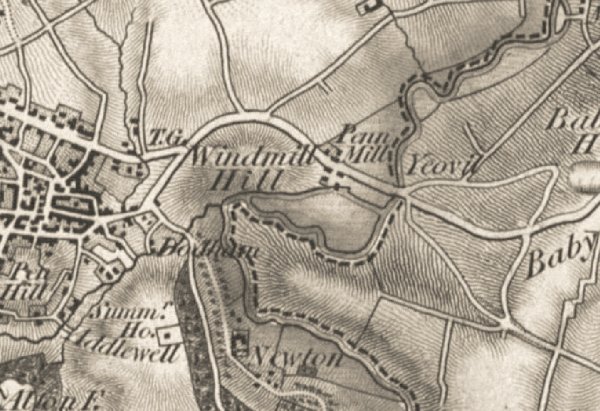
The 1830 Ordnance Survey map showing Windmill Hill at centre.
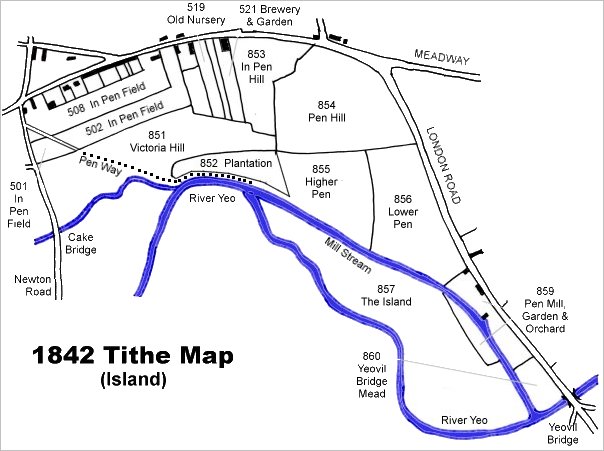
This map, based on the 1842 Tithe Map, shows the constituent parts of Victoria Hill.
For a description of the individual parcels of land click here.
gallery
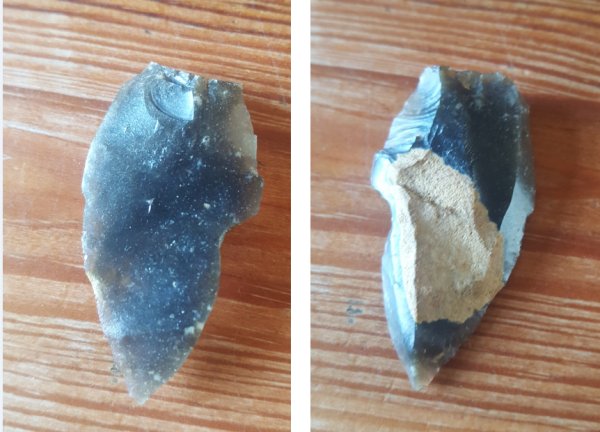
Courtesy of
Jamie Glover
A small (about 2", or 50mm, long) knapped flint tool found on Wyndham Hill. The Stone Age was a broad prehistoric period during which stone was widely used to make tools with an edge, a point, or a percussion surface. The period lasted for roughly 3.4 million years, and ended between 4,000 BCE and 2,000 BCE, with the advent of metalworking.

The Bronze Age (3100 BC to 300 BC) axe found on Wyndham Hill in 1982.
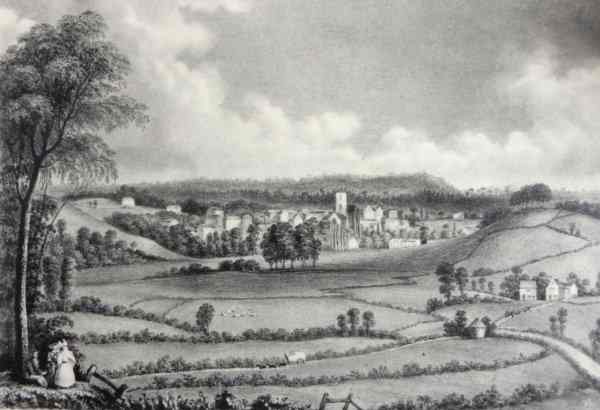
Courtesy of Dave
Shorey
Yeovil seen from Babylon Hill in the late 18th century from a lithograph by T Jerome. Penn Hill is seen at left, surmounted by Penn House, and Wyndham Hill is seen at right with the buildings of Pen Mill at its foot.
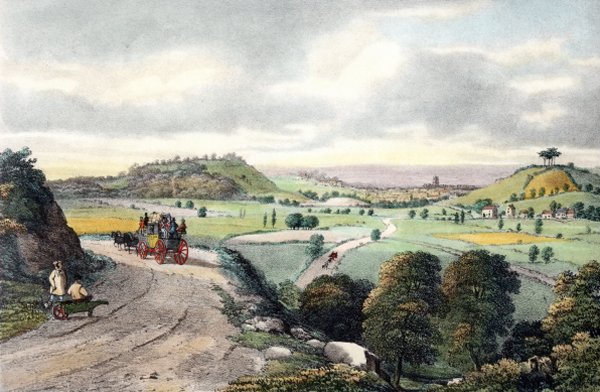
From my
collection
'View of Yeovil from Babylon Hill' in a stone lithograph by Henry Burn (c1807-1884) and published by William Porter and Henry Marsh Custard in January 1839. With Summerhouse Hill at left, with Penn Hill behind it, surmounted by Penn House, and Wyndham Hill at right. The buildings at Pen Mill are seen at the base of the latter, with the tower of St John's church above and to the left. At centre, a coach is seen on the Sherborne Road before it was re-aligned.
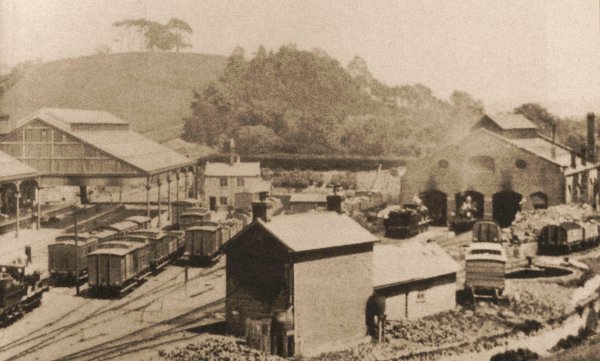
Windmill Hill, now Wyndham Hill, dominates this scene of Yeovil Town railway station, photographed around 1880.
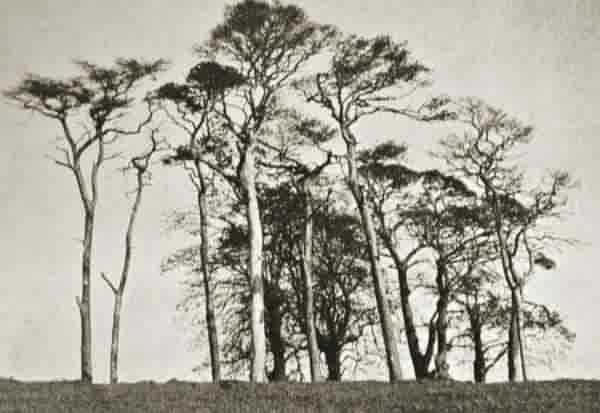
The trees surmounting Wyndham Hill - 25 trees were planted to celebrate Queen Victoria's Silver Jubilee in 1862.
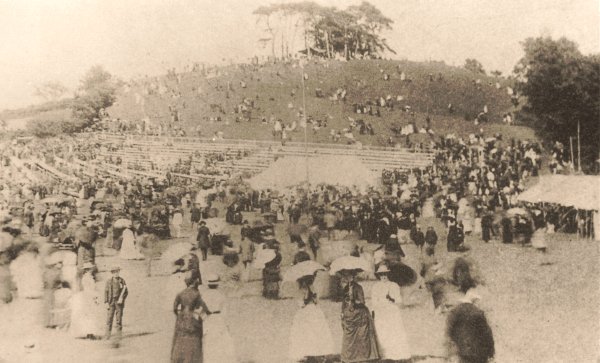
Crowds gather at Wyndham Hill in 1887 to celebrate the Golden Jubilee of Queen Victoria. At this time it was known as Victoria Hill and the lower slopes known as the Fete Field. Notice that at this time there were more than just the four lime trees on the summit. At this time the trees were exactly 25 years old. At centre are seen the tables and seating that accommodated some 3,000 ticket holders for the dinner and, later, Sunday school children for a free tea.
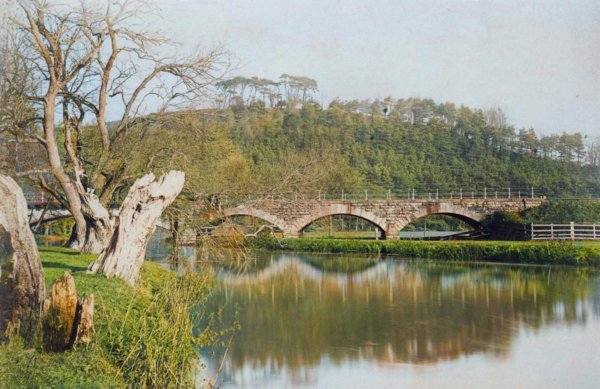
From the Stiby
Collection
(colourised).
Courtesy of South Somerset Heritage Collection
Wyndham Hill still surmounted by many trees photographed around 1885 by Henry Stiby. The railway bridge is long gone.
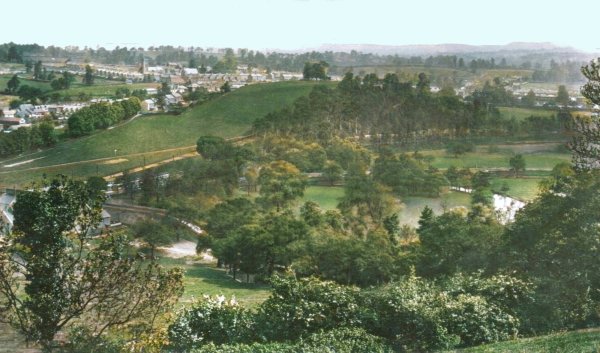
From my
collection
A colourised postcard (the reference number 68919 dates it to 1911) of Wyndham Hill as seen from Summerhouse Hill.
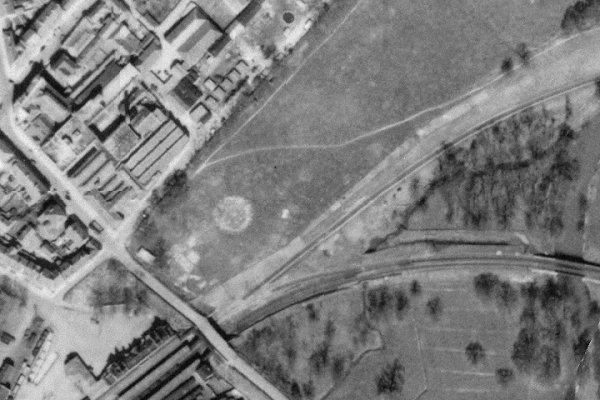
This 1946 aerial photograph is of the eastern end of Wyndham Hill with Newton Road running diagonally across lower left. The round shape in the field just left of centre is a barrage balloon site known as Yeovil Barrage Balloon Site No 14, "Windmill Hill". Associated structures, including a Nissen hut, were located to the west of the circular concrete base.
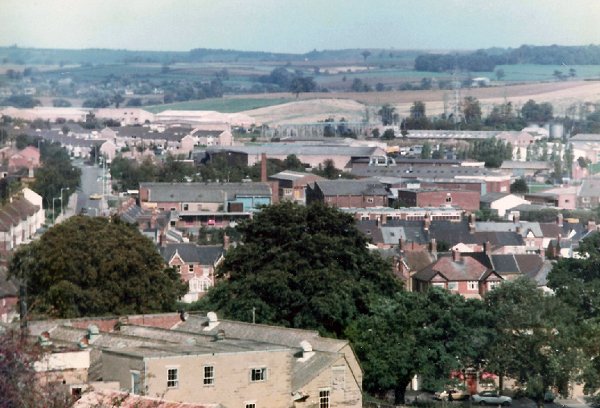
Courtesy of Mark
Fraser
The view northeast from Wyndham Hill with Lyde Road at bottom left. Photographed in 1983.
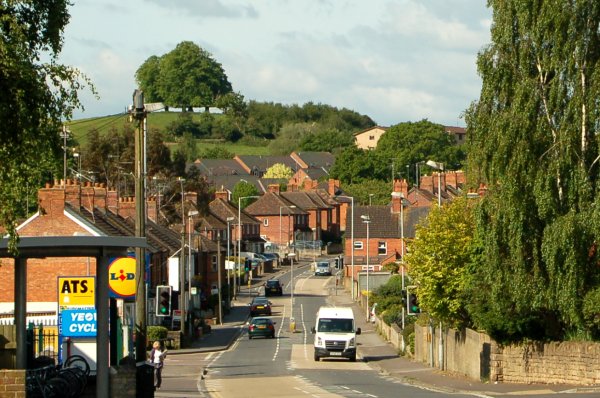
Wyndham Hill dominates the scene of Lyde Road. Photographed in 2013.
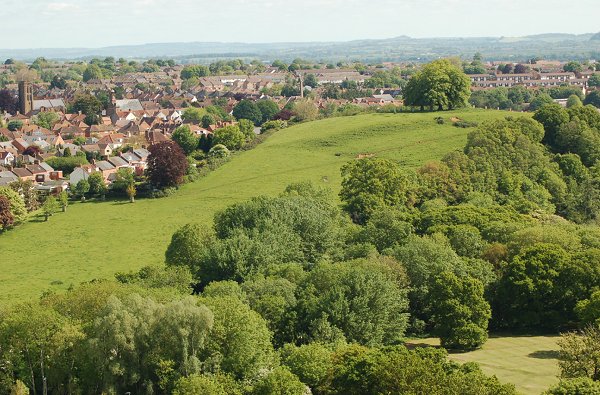
This photograph
features in my
book "A-Z
of Yeovil"
The western flank of Wyndham Hill seen from Summerhouse Hill. Photographed in 2013.
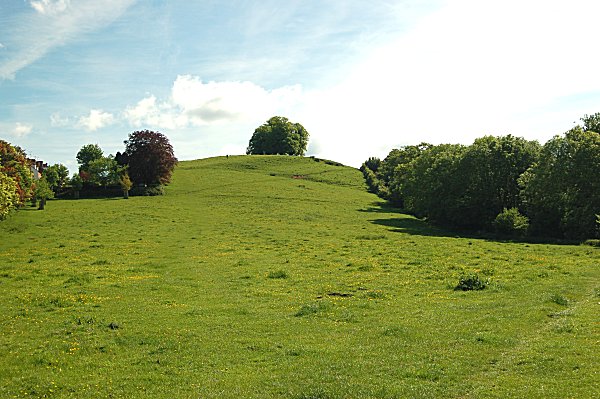
The western flank of Wyndham Hill seen from Newton Road. At the very bottom of the right corner is a trace of the former Penn Way. Photographed in 2013.
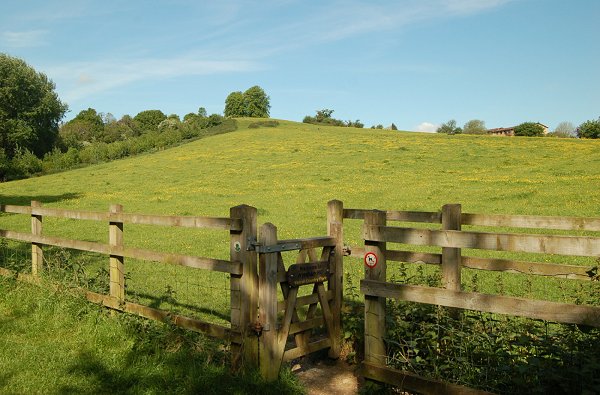
The eastern flank of Wyndham Hill seen from Railway Walk. Photographed in 2013.
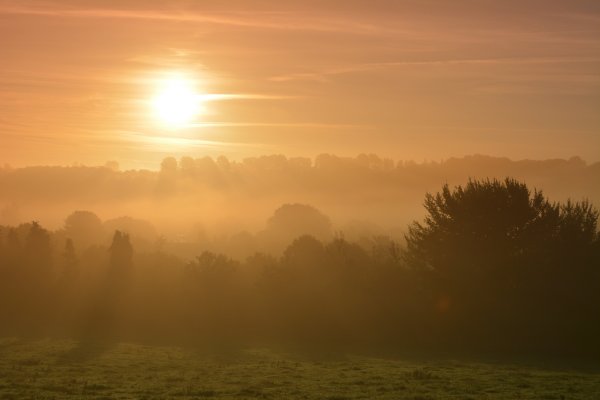
Sunrise seen from Wyndham Hill, looking east towards Babylon Hill. Photographed 2013.
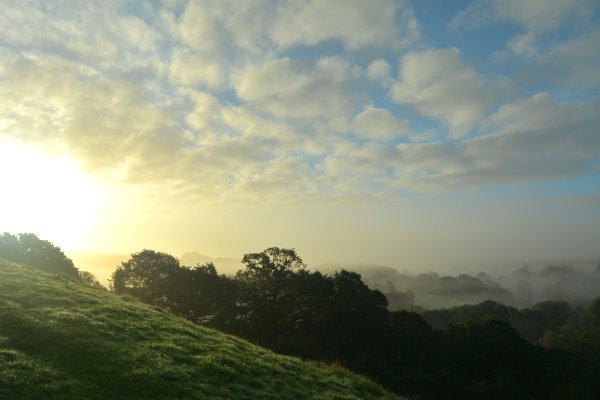
Dawn breaking; seen from Wyndham Hill with mists shrouding the Newton Surmaville valley to the right. Photographed October 2013.
the view from the top
"The town is surrounded on the South East by three remarkable hills - Babylon-hill, Windmill-hill, and Newton-hill. The landscape is also diversified by Newton Copse, the property of George Harbin, Esq., and the beautiful undulating plantations belonging to John Batten, Esq., flanked on the extreme south by some less extensive and elevated grounds, the property of F. Greenham, Esq. From these several points there are prospects so rich in fertility, verdure, and beauty, and smiling prosperity, - such a brightness, a greenness, and a repose, - that the spectator is wrapt in admiration of the view thus spread around and beneath him; and as the hum of distant voices from the busy little town in the valley below reaches his ear, and he looks upon St. John's gray tower, in its hoary age and silent grandeur, rising out of its midst, impressions something akin to adoration force themselves instinctively upon his mind." (Vickery, 1856).
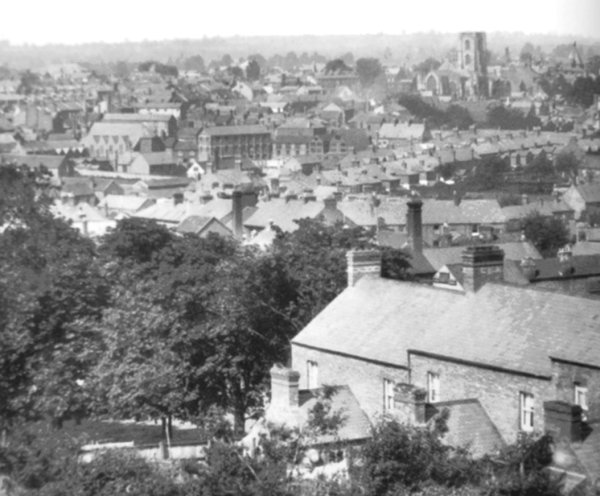
This view across Yeovil from Wyndham Hill dates to about 1900. Note the glove factories at centre and the factory chimneys.
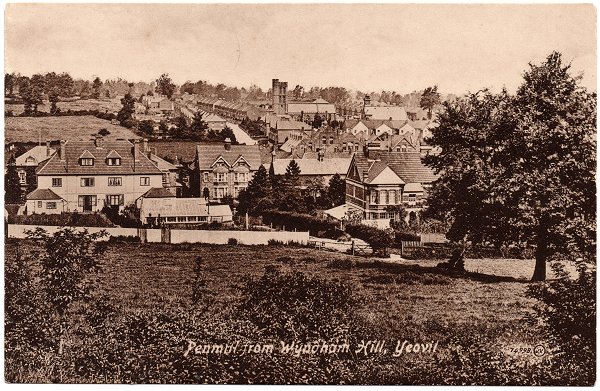
From my
collection
The photograph of this postcard was taken in 1913 from the top of Wyndham Hill. Across the centre of the photograph are the houses of Sherborne Road, at top centre is St Michael's church and to its right is St Michael's Hall. At centre and running to centre right is the Pen Mill Elementary School.
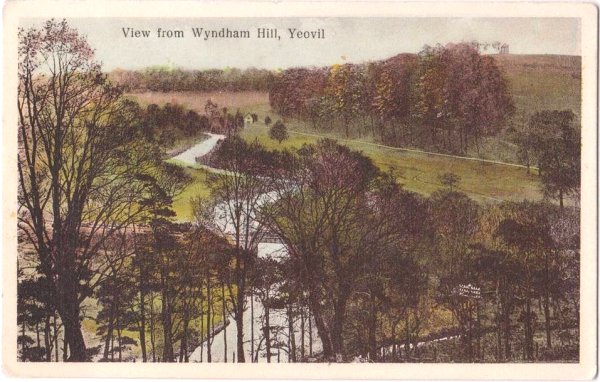
From my
collection.
This
image
features in my
book 'Yeovil
- The Postcard
Collection'.
A hand-coloured postcard of the 1920s looking along the Yeo valley towards Newton House.
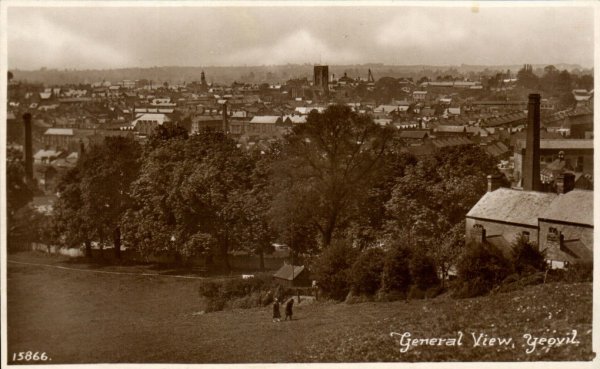
The view across Yeovil from Wyndham Hill - a postcard probably dating to the 1940s.
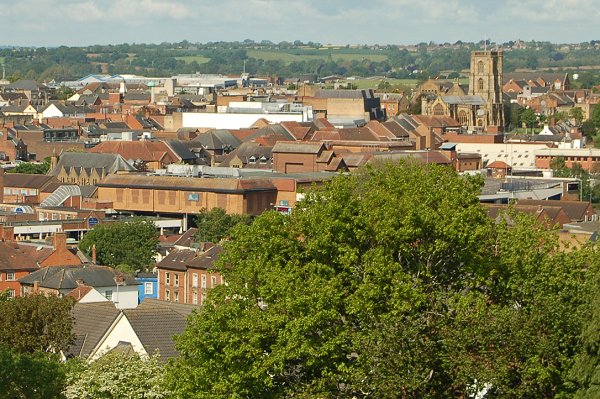
The same view, photographed in 2013.
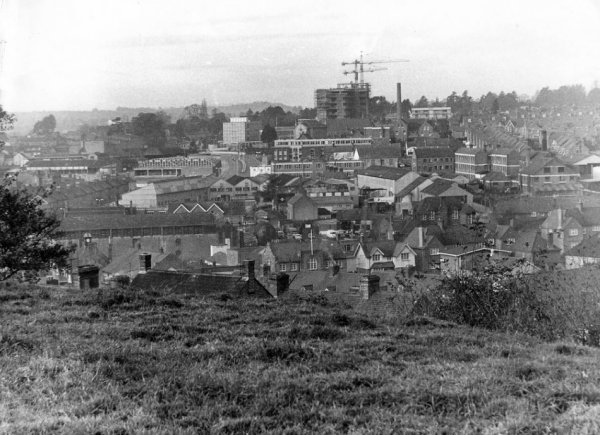
Photographed by
Geoff Bowler,
courtesy of Sue
Bowler
Looking north-northwest in 1969. Reckleford is glimpsed just left of centre and the hospital is under construction on the skyline right of centre.
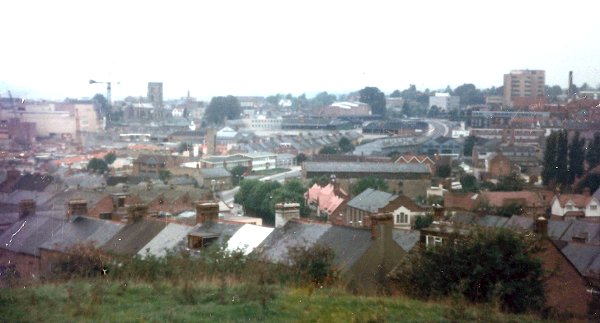
Courtesy of Mark
Fraser
The view northwest from Wyndham Hill photographed in 1983. At left, the crane is part of the scene of the Quedam shopping precinct and between it and the rooftops at lower left, the remains of Vicarage Street can just be made out.
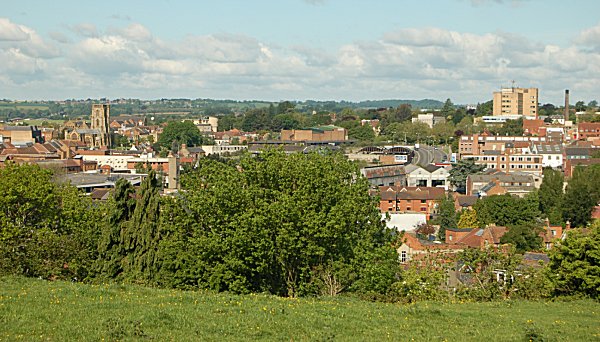
Pretty much the same view as the previous photograph, seen in 2013. St John's church dominates the scene to the left, while the hospital dominates to the right.
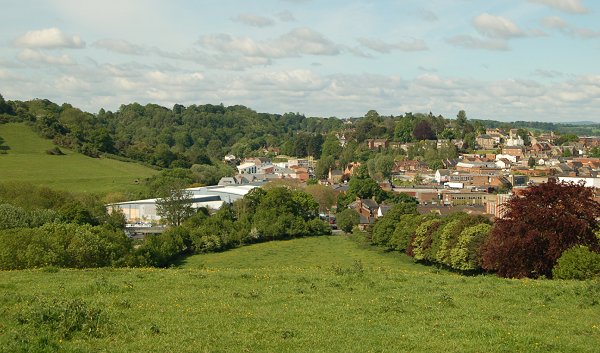
Looking from the summit down towards the gate at Newton Road. At left is Summerhouse Hill, then Ninesprings valley with Penn Hill centre right.
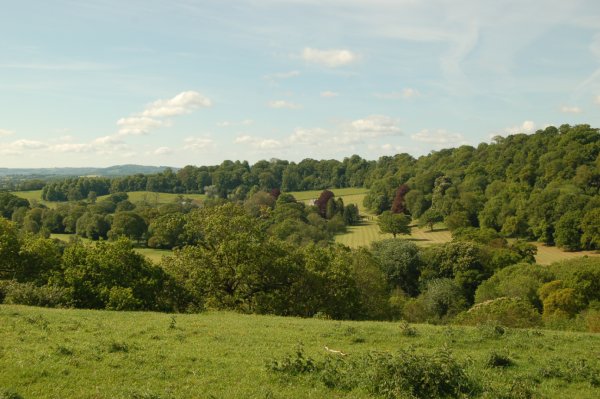
The spectacular view to the south, along the Newton Surmaville valley, with the North Dorset Downs in the far distance at left.
wyndham hill through the year
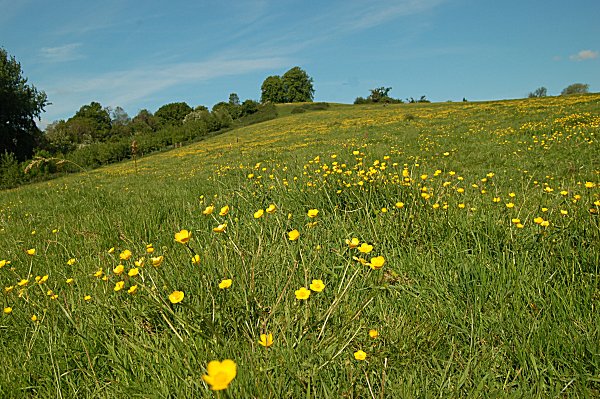
Spring - late spring Buttercups colour the hillside. Photographed 2013.
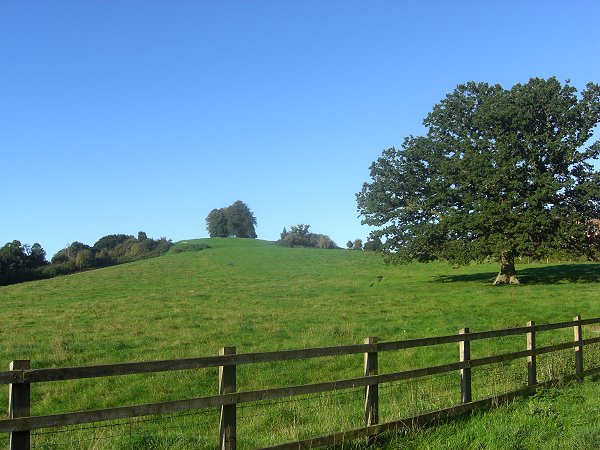
Summer
- Wyndham Hill
seen from the
east on a bright
summer day.
Photographed
2013.
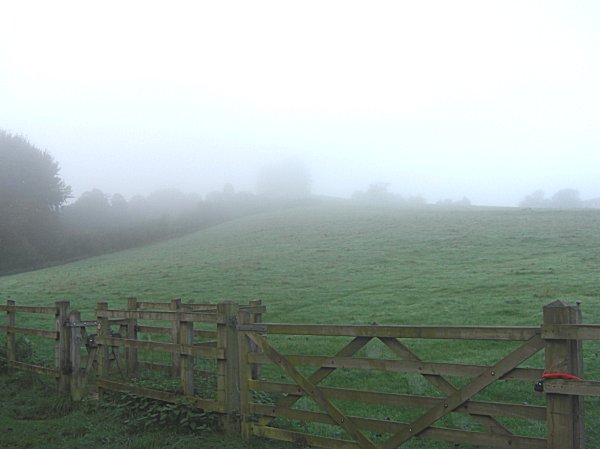
Autumn - Wyndham Hill shrouded in autumn mists. Photographed 2013.
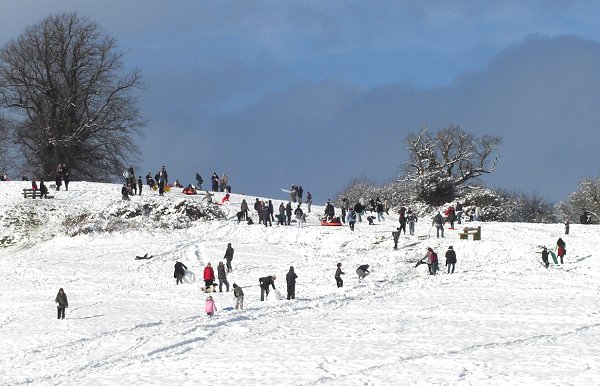
Winter -- crowds play in the snow on top of Wyndham Hill in February 2009.